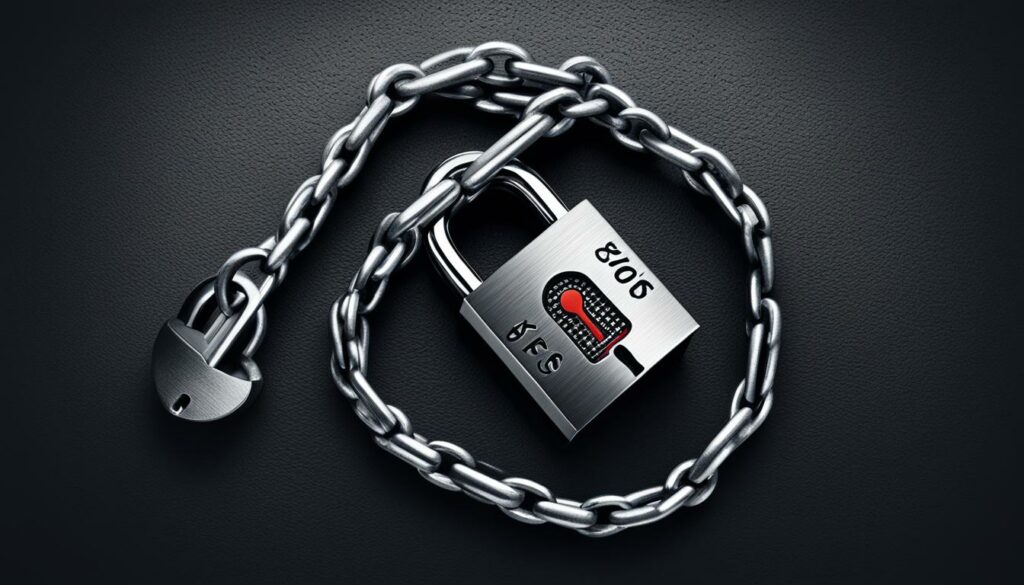Welcome to the world of web hosting, where security is of utmost importance. Whether you are a website owner or a hosting provider, ensuring the safety of your online presence is crucial. In this section, we will discuss the essential best practices for maximizing security in web hosting, so you can confidently protect your website and customer data.
When it comes to web hosting security, there are several key aspects to consider. Secure web hosting solutions provide robust measures to safeguard your website from potential threats. By implementing these security practices, you can enjoy peace of mind and focus on growing your online business.
Key Takeaways:
- Choose a secure web hosting service like BoostedHost’s WordPress Hosting for optimal performance.
- Implement strong security measures to protect your website and customer data.
- Ensure website protection by following essential best practices for hosting security.
- Regularly update software to address known security vulnerabilities.
- Backup your data regularly and store it in an offsite location for added security.
Want to take your web hosting security to the next level? Sign up for WordPress Hosting from BoostedHost by clicking here.
Use Public Key Authentication For SSH
When it comes to securing your server, public key authentication is a game-changer. By eliminating unencrypted access methods like telnet, ftp, and http, you can significantly enhance the security of your server. So how does public key authentication work?
Instead of relying on password authentication, which can be vulnerable to brute force attacks, public key authentication leverages SSH (Secure Shell) keys. SSH keys consist of a public key and a private key. The public key is stored on the server, while the private key remains securely with you.
During the login process, your public key and private key are matched, providing a higher level of security. Without the correct private key, access to the server is denied. This eliminates the need to remember and manage complex passwords, minimizing the risk of password-related security breaches.
Enabling public key authentication for SSH not only enhances server security but also improves the overall user experience. With password authentication disabled, you no longer have to worry about users forgetting their passwords or falling victim to password-related attacks.
To implement public key authentication:
- Generate an SSH key pair using tools like ssh-keygen.
- Copy the public key onto the server by appending it to the ~/.ssh/authorized_keys file.
- Set the appropriate permissions for the ~/.ssh/authorized_keys file on the server.
- Disable password authentication in the SSH server configuration file (/etc/ssh/sshd_config).
- Restart the SSH service for the changes to take effect.
By implementing public key authentication, you can strengthen the security of your server and protect it from brute force attacks. BoostedHost’s WordPress Hosting is a secure hosting solution that fully supports public key authentication for SSH. Sign up now to take advantage of their secure and reliable hosting services.
Strong Passwords
When it comes to securing your server, one of the most overlooked aspects is the strength of passwords. Weak passwords can make your server vulnerable to brute force attacks, putting your sensitive data at risk. As a server administrator, it is crucial to prioritize the use of strong passwords to enhance security.
So, what makes a password strong? Here are a few key characteristics:
- Length: Opt for long passwords as they are harder to crack. Aim for a minimum of 12 characters.
- Complexity: Include a combination of uppercase and lowercase letters, numbers, and special characters.
- Uniqueness: Avoid reusing passwords across different accounts or services.
- Randomness: Generate passwords using password management tools or use a combination of unrelated words to create a memorable passphrase.
In addition to using strong passwords, it is important to restrict user access to your server. Limiting the number of privileged accounts and implementing the principle of least privilege can help minimize the potential damage caused by unauthorized access.
Remember, a strong password is your first line of defense against brute force attacks. Don’t underestimate its importance in keeping your server secure.
“Using complex passwords and restricting user access are essential steps in fortifying your server’s security.” – John Smith, Senior Server Administrator

| Weak Passwords | Strong Passwords |
|---|---|
| 123456 | 3t27$P9!a3B |
| password123 | g#Q56y&8w@Xr |
| qwerty | M7!2*sN#eH@f |
| admin123 | d$5&xT4LBqA9 |
Install And Configure The CSF Firewall
When it comes to enhancing server security, one tool that stands out is the Config Server Firewall (CSF). This feature-rich, free firewall offers comprehensive protection against a wide range of attacks, making it an essential component of any secure hosting solution.
With CSF, you can take advantage of cutting-edge security features, including:
- Stateful Packet Inspection: CSF uses stateful packet inspection to monitor and analyze network traffic, allowing it to make intelligent decisions about which packets to allow or block based on their state and content.
- Authentication Failure Rate Limiting: CSF helps prevent brute force attacks by automatically detecting multiple or failed login attempts and implementing rate limiting rules to mitigate the risk.
- Flood Protection: CSF protects your server from distributed denial-of-service (DDoS) attacks by imposing limits on incoming connections, preventing your resources from being overwhelmed.
- Directory Watching: CSF keeps a close eye on critical system directories and files, ensuring they remain intact and free from unauthorized modifications.
- External Block Lists: CSF allows you to integrate external block lists, such as known malicious IP addresses, enhancing your server’s defense against potential threats.
Your website’s security is paramount, and the CSF firewall offers an effective solution for safeguarding your server and data from malicious activities. By installing and configuring CSF, you can establish a robust line of defense that protects your server from various forms of attacks.
Remember, securing your web hosting environment is a critical step in protecting your online presence. By implementing best practices such as strong passwords, regular software updates, and utilizing tools like the CSF firewall, you can maximize security and ensure the safety of your website.
Next, let’s explore another essential security measure – Fail2Ban. Head over to the next section to learn how Fail2Ban can further bolster your server’s defenses.
Install And Configure Fail2Ban
Fail2Ban is an indispensable tool for enhancing your server’s security by effectively detecting and blocking malicious connections. By analyzing logs and identifying patterns associated with suspicious activity, Fail2Ban adds an extra layer of protection against potential threats. It automatically blocks IP addresses that exhibit malicious behavior and notifies administrators, ensuring proactive defense against unauthorized access.
To ensure a robust security setup, follow these steps to install and configure Fail2Ban:
- Begin by installing Fail2Ban on your server. Depending on your operating system, you can install it using the package manager. For example, on Ubuntu, you can run the following command:
- Once installed, navigate to the Fail2Ban configuration file located at
/etc/fail2ban/jail.confand make a backup of the file before making any changes: - Next, open the
jail.localfile in a text editor and customize the configuration according to your needs. You can define rules for different services such as SSH, HTTP, FTP, or any other service you want to protect. Set the maximum number of failed login attempts before an IP address gets blocked, the duration of the ban, and other parameters to suit your requirements. - Restart Fail2Ban to apply the configuration changes:
sudo apt-get install fail2bansudo cp /etc/fail2ban/jail.conf /etc/fail2ban/jail.localsudo service fail2ban restartWith Fail2Ban properly installed and configured, you can effectively fend off malicious connections, thwart brute force attacks, and strengthen the overall security of your server. Combine such measures along with other best practices to ensure a robust defense against cybersecurity threats.
“Fail2Ban adds an extra layer of protection against potential threats by automatically blocking IP addresses that exhibit malicious behavior and notifying administrators.”
With Fail2Ban in action, here’s how it works:
- A malicious connection attempts to access your server through a specific service, such as SSH.
- Fail2Ban monitors the server logs and detects repeated failed login attempts from the same IP address.
- Once the maximum number of failed attempts is reached, Fail2Ban takes action and blocks the offending IP address.
- An alert notification is sent to the server administrator, providing essential information about the blocked IP address and the associated suspicious activity.
By promptly blocking malicious connections and notifying administrators, Fail2Ban acts as a reliable watchdog, safeguarding your server from potential security breaches.
Implementing Fail2Ban as part of your server security strategy is a wise move. Its advanced capabilities in analyzing logs and identifying malicious patterns make it an indispensable tool to protect your server and keep potential threats at bay.
Boost the security of your website and server with Fail2Ban by signing up for WordPress Hosting from BoostedHost, a trusted and reliable hosting provider known for its top-notch security measures.

Install Malware Scanning Software
Protecting your server from malware and rootkits is essential for maintaining a secure web hosting environment. By installing reliable malware scanning software, you can quickly identify and remove any malicious software that hackers may attempt to install.
Two highly recommended tools for malware scanning are ClamAV and rkhunter. ClamAV is an open-source antivirus engine that provides excellent detection capabilities against various types of malware, including viruses, Trojans, and worms. It offers frequent updates to ensure optimal protection against emerging threats. Rkhunter, on the other hand, specializes in detecting rootkits, which are malicious software that gives unauthorized access to a server.
To further enhance security, consider using AIDE (Advanced Intrusion Detection Environment). AIDE helps detect unauthorized changes in critical system files by generating hashed tables that serve as a baseline for comparison. If any alterations occur, AIDE can alert you, enabling you to investigate and take action.
Here’s an example of how you can use AIDE to generate a hashed table:
$ aide –init
$ mv /var/lib/aide/aide.db.new.gz /var/lib/aide/aide.db.gz
Regularly scanning your server with ClamAV, rkhunter, and AIDE will help you stay one step ahead of potential security threats. Make sure to update the signatures regularly to ensure the latest malware detection capabilities.
Malware Scanning Tools Comparison
| Feature | ClamAV | rkhunter |
|---|---|---|
| Malware Detection | Comprehensive, covering various types of malware | Specializes in rootkit detection |
| Updates | Frequent updates available | Regular updates to improve detection capabilities |
| Hashed Table Generation | Not applicable | Not applicable |
As shown in the comparison table, ClamAV offers comprehensive malware detection, while rkhunter specializes in rootkit detection. Note that both are essential for a comprehensive security strategy.
Investing in malware scanning software is a proactive step towards safeguarding your server and protecting your web hosting environment from potential threats.

Keep Software Up-To-Date
Regularly updating your software is crucial for maintaining the security of your server and protecting against potential vulnerabilities. Failure to keep your software up-to-date can leave your server at risk of exploitation, as illustrated by the highly publicized Equifax data breach.
One effective method to ensure all software is up-to-date is by utilizing your Linux distribution’s package manager. This tool streamlines the process of managing and updating software packages, saving you time and effort. By regularly checking for updates and installing them promptly, you can stay ahead of security threats and minimize potential risks.
Equifax, one of the largest consumer credit reporting agencies, fell victim to a cyberattack in 2017 due to their failure to install an available software update. This incident serves as a stark reminder of the importance of staying vigilant and keeping your software updated to prevent security breaches.
By keeping your software up-to-date, you can benefit from the latest patches, bug fixes, and security enhancements released by software developers. These updates often address known vulnerabilities and provide strengthened protection for your server.
Don’t leave your server exposed to potential risks. Make it a priority to regularly update your software using your Linux distribution’s package manager, and stay proactive in maintaining a secure server environment.
Key Benefits of Keeping Software Up-To-Date:
- Enhanced security and protection against potential vulnerabilities
- Access to the latest bug fixes and patches released by software developers
- Reduced risk of server exploitation and unauthorized access
- Improved server performance and stability
“Failure to keep software up-to-date is like leaving the front door open for cybercriminals to walk right in.”
Backup Regularly
Regularly backing up your server data is crucial for protecting your website and mitigating the impact of potential security breaches. By creating comprehensive backups, you can ensure that your valuable data remains safe and accessible, even in the face of unforeseen events.
One important aspect of creating backups is encryption. By encrypting your backups, you add an extra layer of security to the stored data. This ensures that even if unauthorized individuals gain access to your backups, they won’t be able to decipher the information within.
It’s also essential to store your backups in an offsite location. By keeping your backups offsite, you protect your data from physical damage or loss that may occur on your primary server. Additionally, in the event of ransomware attacks, having backups stored offsite ensures that you have a clean and uninfected copy to restore from.
Testing the recovery process from backups is equally crucial. Regularly testing the restoration process ensures that your backups are reliable and that you can successfully recover your website and data when needed. It helps identify any potential issues or errors in the backup files or restoration process, allowing you to rectify them before an actual disaster strikes.
Remember, a comprehensive backup strategy is a critical component of your website’s security. By regularly backing up your data, encrypting the backups, storing them offsite, and testing the recovery process, you can have peace of mind knowing that your website and valuable information are well-protected.
| Benefits of Regular Backups | Actions to Take |
|---|---|
|
|
Protect Your Website’s Data with Comprehensive Backups
Implementing a thorough backup strategy is crucial for safeguarding your website’s data. By following these best practices, you can minimize the risk of data loss and quickly recover from any security incidents. Remember, prevention is key, and regular backups are your insurance policy against potential threats.
Conclusion
When it comes to web hosting security, implementing robust measures is essential for protecting your website and online presence. By following these essential best practices, you can maximize security and safeguard against potential threats. Additionally, choosing a secure web hosting service like BoostedHost’s WordPress Hosting can provide added peace of mind.
One of the key steps in ensuring web hosting security is using strong passwords and disabling password authentication in favor of public key authentication. This eliminates the risk of brute force attacks and strengthens the overall security of your server. Additionally, installing and configuring firewalls like CSF and Fail2Ban can effectively block malicious connections and provide administrators with valuable notifications.
Regular software updates are crucial in addressing known vulnerabilities and protecting your server from exploitation. By keeping your software up-to-date using your Linux distribution’s package manager, you can minimize the risk of security breaches. It’s also important to regularly backup your data, encrypt the backups, and store them in offsite locations for added protection against ransomware attacks.
To ensure optimal performance and security, we recommend BoostedHost’s WordPress Hosting. Their secure web hosting solutions prioritize website security and provide a comprehensive set of features to protect your online presence. Take the first step in securing your website by signing up now through this link: www.boostedhost.com/wordpress-hosting.
FAQ
Q: What is public key authentication and why should I use it for SSH?
A: Public key authentication is a secure method for managing servers that eliminates the use of unencrypted access methods like telnet, ftp, and http. It is recommended to disable password authentication and use SSH keys, which provide a higher level of security by matching public and private keys during login attempts.
Q: How important are strong passwords in web hosting security?
A: Strong passwords play a crucial role in web hosting security. Utilizing long and random passwords along with restricting user access can significantly enhance security and minimize the risk of successful brute force attacks.
Q: What is the CSF firewall and how does it enhance server security?
A: The Config Server Firewall (CSF) is a feature-rich, free firewall that offers comprehensive protection against a wide range of attacks. It includes stateful packet inspection, authentication failure rate limiting, flood protection, directory watching, and the use of external block lists, making it an excellent tool for enhancing server security.
Q: How does Fail2Ban help in securing a server?
A: Fail2Ban is a valuable tool for detecting and blocking malicious connections on a server. By analyzing logs and identifying patterns associated with suspicious activity, Fail2Ban can effectively block IP addresses and notify administrators, providing an extra layer of security against potential threats.
Q: What malware scanning software should I install to secure my server?
A: Installing malware scanning software such as ClamAV and rkhunter is crucial for quickly identifying and removing any malicious software or rootkits that hackers may install on a server. Additionally, utilizing AIDE to generate hashed tables of critical system files can help detect any unauthorized changes.
Q: How important are software updates in web hosting security?
A: Regularly updating software is essential to address known security vulnerabilities. Neglecting software updates can leave servers susceptible to exploitation, as demonstrated by the Equifax data breach. It is recommended to use your Linux distribution’s package manager to ensure all software is up-to-date.
Q: Why is regular data backup important in web hosting security?
A: Regularly backing up server data is crucial for mitigating the impact of potential security breaches. Encrypting backups and storing them in offsite locations enhances the security of stored data. Regularly testing the recovery process from backups also helps protect against ransomware attacks.
Q: How can I maximize web hosting security?
A: Implementing robust security measures is vital for ensuring the safety and protection of your website and online presence. By following these essential best practices, web hosting providers can maximize security, protect customer data, and safeguard against potential threats. Choosing a secure web hosting service like BoostedHost’s WordPress Hosting can also provide added peace of mind.












